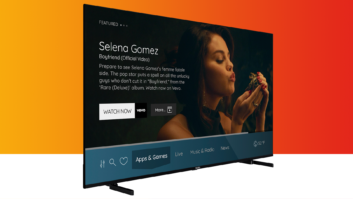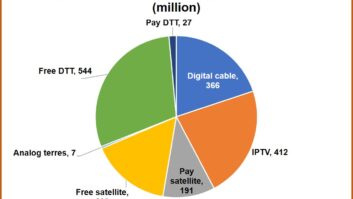In an era marked by fierce competition within the video entertainment industry, pay-TV operators currently face a dual challenge: delivering compelling content and innovative service to help them differentiate and grow revenues, while at the same time keeping their operating costs down.

In the fragmented content landscape we find ourselves in, consumers are frustrated with how dispersed content has become, studios struggle to reach wide audiences, and pay-TV and telco operators face a tough challenge in innovating service at the pace necessary to grow subscribers, whilst still remaining profitable. Fortunately, the focus for many operators over recent years has been on aggregating content from a wide range of sources and adding a unified user experience, search and discovery on top, i.e., super-aggregation. Bringing content together satisfies the consumer and studio frustration, and also helps draw in and keep subscribers. It’s no surprise then that it’s been heralded as a strategic imperative of sorts in recent years. But despite the myriad benefits of the approach, recent research from Caretta and Irdeto found that this is still a work in progress, with little more than half of global platforms surveyed, suggesting that they are currently integrating third-party streaming apps into their offer alongside more traditional TV channels and Video on Demand (VoD).
The journey toward super-aggregation demands a holistic approach, blending innovative technologies, strategic partnerships, and relentless investment in infrastructure and software platforms. As operators prioritise subscriber engagement with the need to keep tight control over costs, has super-aggregation now taken a back seat in transformation plans?
Is super-aggregation still a priority?
For the majority of operators, scaling up to reach more devices and delivering OTT-only services to unmanaged devices remain top priorities. But as cost pressures bear heavy, some are even considering a “boxless” future, moving away from managed devices altogether and simply delivering content via their own apps on unmanaged devices like smart TVs, streaming sticks and mobiles. This is, however, a red herring as keeping control of the customer experience is critical to the long-term success of operator business models.

User experience dominates the list of investment priorities with many of the operators surveyed by Caretta suggesting that analytics, front-end UI and more robust video infrastructure rank the highest when it comes to how they’ll improve experience. Understanding video consumers is a prerequisite for growing subscription and advertising revenues, while carefully monitoring their activity and quality of experience is essential for reducing churn. A ‘boxless’ future would severely impede operators’ ability to understand and, build for consumers.
With these myriad transformation priorities, it’s unsurprising that progress toward super-aggregation has been somewhat limited. However, amidst the challenges, there are some great examples of operators embracing the super-aggregation model to counter the surge and popularity of SVoD competitors. In the UK, telco and TV provider BT has bundled offerings of Netflix and Sky Group’s streamer NOW, as well as Prime Video via its mobile product EE TV. Beyond the UK, Swisscom is a notable super-aggregator with its blue TV bundle which provides customers access to Disney+, Paramount+ Sky Cinema, and the telecom’s dedicated streaming offering blue SuperMax. Sky has also taken a lead with super aggregation with Netflix bundled in the operator’s TV offerings, and Disney+ offered as an add-on to TV services. The service provider also hard-bundles Warner Bros. Discovery’s discovery+ through its SkyQ TV platform. Super-aggregation remains the best way to combat content fragmentation, so given the benefit to content providers and consumers, what is limiting progress here?
What’s getting in the way?
To stay competitive in the pay-TV sector, transitioning towards a super-aggregator model clearly offers many advantages and almost seems like it should be an existential priority. But it is a complex endeavour which can’t successfully be pursued alone. Whilst in the past, technology priorities could have been met by limited in-house resources, the current landscape has forced a change of pace. According to the Caretta research, 70% of the operators surveyed have less than 100 engineers, and they’re typically focused on maintaining legacy technology stacks. To meet the transformation imperative, operators are somewhat dependent on third parties and only 12% of those surveyed opted for a full ‘build it yourself’ approach. For the majority buying some or all of their technology stack from vendors a customised approach was most common, with more than 40% of operators buying components and then integrating and customising them further. This approach can maximise the impact of limited in-house development and engineering resources, allowing for competitive differentiation in key customer touch points and user experience, while avoiding the wasted cost and time of reinventing the wheel.
However, a range of more specific challenges also exist as operators look to bundle services:
The app integration challenge: The time it takes to complete integration and obtain certification from international streaming services before an aggregated service can launch tends to be an obstacle. In fact, some operators, particularly smaller ones, find they can’t get the support or certification from some app providers at all. Beyond this, integrating third-party app metadata into search and the frontend user experience is one of the most challenging aspects of the integration, despite its potential to transform user experience.
King content still reigns supreme. When consumers have multiple ways to access a similar range of international content and apps, platform operators are paying closer attention to how unique and premium content – mainly original production and sports rights – can help differentiate their service. Access to premium content remains one of the biggest challenges for platforms over the next five years.
There are also additional questions around control of user data and competition from illegal super-aggregated IPTV services. The goal of universal content discovery is best achieved with control of user data. However, access to data can be limited, with content providers often not wanting to share with other platform operators.
The future of super-aggregation
Despite these challenges, the future of super-aggregation appears promising. For most that are pursuing aggregation, it’s a mix of local or regional streaming services, plus the international majors like Netflix, Prime Video and Disney+. According to Caretta, most are providing five or fewer integrated apps in any one category with only a handful of platforms aggregating more than five apps. However, operators are also diversifying their integrated app portfolios beyond video streaming, incorporating smart home, gaming, music, and health services to bolster revenue streams. A full third of operators that are pre-integrating third-party apps are now including these “digital lifestyle” services.
Super-aggregation remains a core strategy for operators aiming to enhance user experience and retain subscribers. By integrating third-party streaming apps and traditional channels, operators can offer a comprehensive content library, reverse content fragmentation and take back ownership of delivering an integrated user experience. As operators navigate this transition, and in the face of a talent crunch, the good news is that they don’t have to go it alone.







